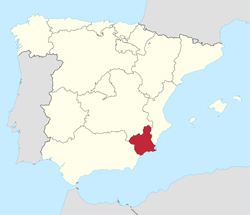Murcia in Murcia

 The Region of Murcia is a uniprovincial autonomous community, meaning that it comprises only one province.
The Region of Murcia is a uniprovincial autonomous community, meaning that it comprises only one province.
It borders on Almería, Granada, Alicante and Albacete provinces as well as on the Mediterranean Sea.
The region is home to 1,493,898 (2019) souls of which at least one third live in the capital of the same name.
Although it comprises only one province, the Region of Murcia is nevertheless Spain’s 9th largest autonomous community as far as surface is concerned, and the 10th with respect to inhabitants. In its status as province it is the 7th most populated of the 50 that constitute Spain.
The highest point in Murcia is in the Revolcadores Massif at 2,015 MASL.
Murcia is one of Europe’s largest producers of fruit, vegetables and flowers, and it is home to some of Spain’s most important wine growing areas such as Jumilla. Bullas and Yecla all of which produce DO wines (Denominación de Origen).
Murcia’s importance as a tourist destination is growing and there are numerous golf resorts inhabited both by residents and holidaymakers. The region’s largely unspoilt coastline also attracts visitors from all over.
The climate in Murcia is hot and dry, and the extensive fruit, vegetable and flower fields are irrigated by the rivers that flow through the region, notably the Segura River.
The Regional Assembly of Murcia is based in Cartagena which turns this city into the ‘legislative capital’, but this denomination is not included in the autonomy statutes, and the city of Murcia is considered the capital of the region.
The city of Murcia has a very important services sector; it used to be known as an agricultural export centre thanks to the extensive arable farming in the surrounding area which was known as the ‘Orchard of Europe’, but the tertiary sector is the most important in the city today.
However, industry is also plentifully represented, including alimentary, textile and chemical factories. The great majority of the industrial installations are to be found on the Polígono Industrial Oeste (Western Industrial Estate) which is one of the largest on the Iberian Peninsula.
Murcia is also an important university city. The first university was founded there 1272, and today there are two large universities, the public Universidad de Murcia and the private Universidad Católica San Antonio. Between them they have around 50,000 students.


